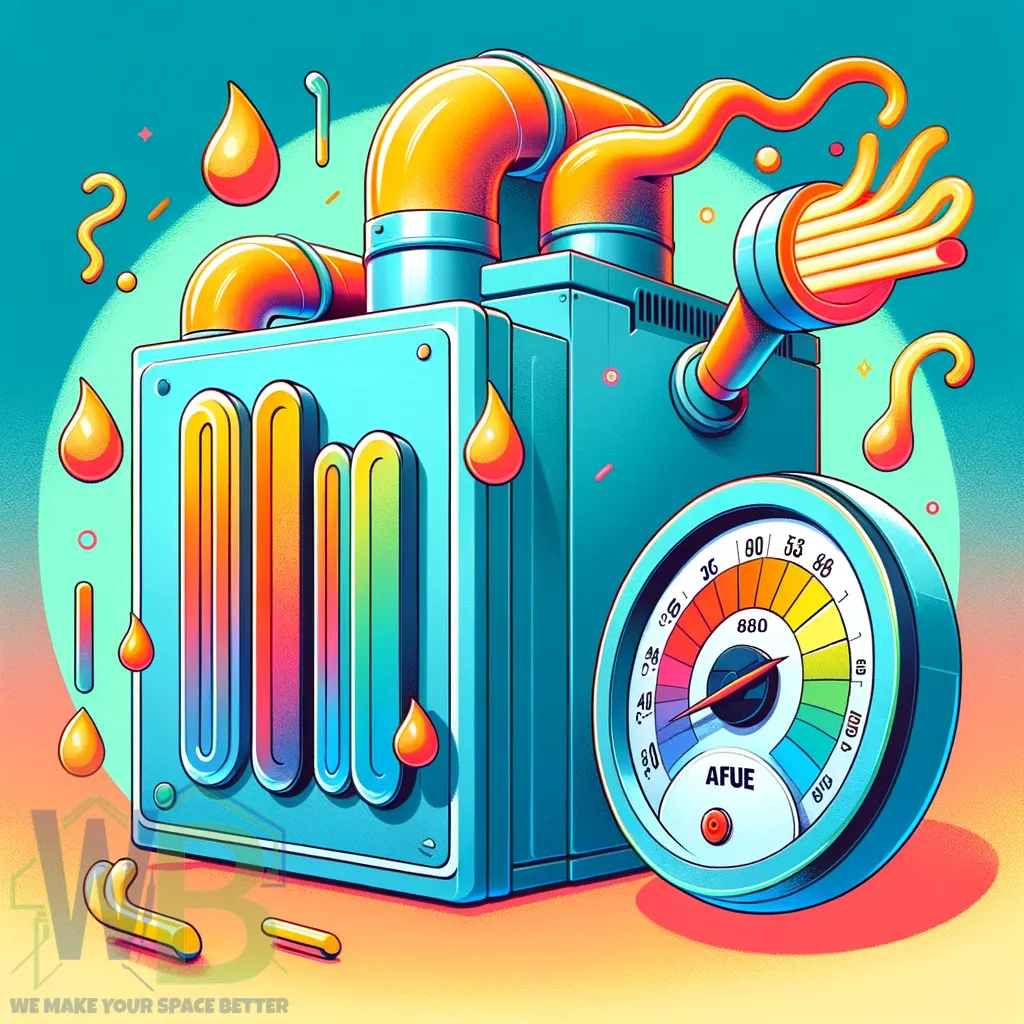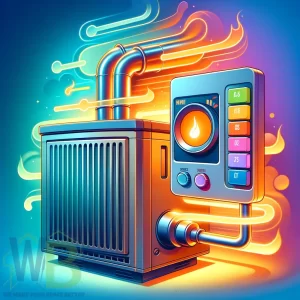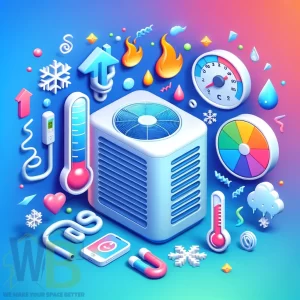AFUE stands for Annual Fuel Utilization Efficiency. It’s a standard measure to rate the efficiency of furnaces and boilers.
This measure tells us how well these systems convert fuel into heat. In other words, AFUE measures how much bang for your buck you’re getting in heating.

Quick Summary
| Section | Key Points |
|---|---|
| What is AFUE in HVAC? | – AFUE stands for Annual Fuel Utilization Efficiency. – Measures furnace/boiler efficiency. |
| How AFUE is Calculated | – Ratio of heat output to fuel input. – Expressed as a percentage. |
| Different AFUE Ratings | – 80-85% (Good), 90-95% (Better), Above 95% (Best). – Higher rating = more efficiency. |
| Factors Influencing AFUE | – Includes system age, fuel type, maintenance, installation quality, system design, home insulation. |
| Cost-Benefit Analysis of High AFUE | – Higher initial cost but long-term savings. – More efficient, lower fuel bills. |
| Environmental and Economic Impact | – Reduces carbon footprint and energy consumption. – Economic savings on fuel bills. |
| Choosing the Right AFUE Rating | – Based on climate, home insulation, budget, long-term costs. |
| Conclusion | – Importance of understanding AFUE for efficient, cost-effective home heating. |
What Does AFUE Stand for?
Annual Fuel Utilization Efficiency: Imagine you have a furnace at home. You want it to turn as much fuel into heat as possible. AFUE helps you understand this.
The higher the AFUE percentage, the more efficient the furnace or boiler is. This means less fuel is wasted, which is good for your wallet and the environment.
Let’s break this down a bit more:
- AFUE Percentage: This is the key number. It shows the efficiency of your heating system. A higher percentage means better efficiency.
- Fuel into Heat: The main job of your furnace or boiler is to convert fuel (like gas or oil) into heat. AFUE tells you how well it does this.
- Efficiency Matters: An efficient system saves you money on fuel costs and is better for the environment since it wastes less energy.
Understanding AFUE is crucial when you’re looking to install a new heating system or want to evaluate the performance of your current one.
It helps you make informed decisions about your home’s heating, ensuring you choose an efficient and cost-effective system in the long run.
How AFUE is Calculated

To understand how AFUE is calculated, think of it like a report card for your furnace or boiler.
This calculation gives you a clear percentage, showing how much of the fuel is turned into usable heat for your home compared to the total amount of fuel consumed.
Here’s a simple way to look at it:
- Fuel Consumption: First, we measure the total fuel consumed by your heating system over a year.
- Heat Production: We find out how much of that fuel was converted into heat.
- Percentage Calculation: Finally, we divide the heat produced by the total fuel used and multiply by 100 to get a percentage. This is your AFUE rating.
For example, if your furnace converts 80% of the fuel into heat, it has an AFUE rating of 80%. This means 20% of the fuel is wasted, not contributing to heating your home.
Understanding this calculation is important for a few reasons:
- Efficiency Awareness: Knowing your system’s AFUE helps you understand its efficiency.
- Cost Implications: A lower AFUE means more fuel waste and higher costs.
- Upgrade Decisions: If your system has a low AFUE, it might be time to consider an upgrade for better efficiency and cost savings.
Understanding AFUE ratings helps you choose better heating for your home. This can save you money and make your house more comfortable.
Different AFUE Ratings and What They Mean
AFUE ratings can be considered grades for your heating system’s efficiency. Just like in school, a higher grade means better performance. Here’s a simple breakdown of what different AFUE ratings mean:
- 80% to 85% AFUE: This is like a ‘B’ grade. It’s good, but not the best. These systems are typically older or standard-efficiency models. They do a decent job but aren’t the most efficient.
- 90% to 95% AFUE: This is an ‘A’ grade. These are high-efficiency systems. They use less fuel than older models, saving you money on fuel bills.
- Above 95% AFUE: This is the ‘A+’ range. These are ultra-high-efficiency systems. They’re top-of-the-line regarding energy use and can significantly reduce your heating costs.
Why do these ratings matter?
- Cost Savings: The higher the AFUE rating, the more you save on fuel bills. A higher-efficiency furnace or boiler uses less fuel to heat your home.
- Environmental Impact: High AFUE ratings mean less waste and lower carbon emissions. This is better for the planet.
- Comfort: Efficient systems provide consistent warmth and comfort in your home.
Understanding these ratings helps you make informed decisions about your home heating. It’s about finding the right balance between initial cost and long-term savings.
Factors Influencing AFUE

Several factors can affect the AFUE rating of a furnace or boiler. Understanding these can help you make better choices and maintain the efficiency of your heating system.
- Age of the System: Older furnaces and boilers generally have lower AFUE ratings. Technology has improved over the years, making newer models much more efficient.
- Type of Fuel: The kind of fuel your system uses can impact its efficiency. For example, electric furnaces often have higher AFUE ratings compared to gas or oil furnaces.
- Maintenance: Regular maintenance is key. A well-maintained furnace or boiler runs more efficiently. This means cleaning, checking for leaks, and ensuring all parts are in good working order.
- Installation Quality: How well your system is installed affects efficiency. Poor installation can lead to heat loss and lower AFUE ratings.
- System Design: The design of the heating system also plays a role. Features like variable speed blowers and modulating heat outputs can improve efficiency.
- Home Insulation: Good insulation in your home means less heat loss. This helps your heating system work more efficiently, improving its AFUE rating.
Remember:
- Regular check-ups and maintenance can keep your system running efficiently.
- Consider upgrading an old system for better efficiency and cost savings.
- Good installation and home insulation are crucial for maximum efficiency.
Understanding these factors helps you keep your heating system running at its best. It’s not just about the system but how it’s maintained, and your home is set up.
Cost-Benefit Analysis of High AFUE Furnaces
When considering a high AFUE furnace, it’s important to weigh the costs against the benefits. Here’s a simple way to understand this analysis:
Initial Cost vs. Long-Term Savings:
- Higher Initial Cost: High AFUE furnaces often cost more upfront. This is because they’re equipped with advanced technology to improve efficiency.
- Long-Term Savings: Although the initial cost is higher, these furnaces save you money in the long run. They use less fuel, which means lower fuel bills.
- Break-Even Point: Over time, the savings on your fuel bills can offset the higher initial cost. This is known as the break-even point.
Environmental and Comfort Benefits:
- Environmentally Friendly: High AFUE furnaces are better for the environment. They produce less waste and emissions.
- Improved Comfort: They often provide more consistent and comfortable heat distribution in your home.
Making the Decision:
- Consider your budget and how long you plan to stay in your home. If you’re staying long-term, the savings can be substantial.
- Think about the climate. In colder areas, the efficiency of your furnace is even more crucial.
- Factor in potential rebates and incentives for energy-efficient appliances.
A high AFUE furnace is an investment. It may cost more upfront, but the long-term savings and environmental benefits can make it a wise choice. Always consider your specific situation and needs when making this decision.
Environmental and Economic Impact

The environmental and economic impact of AFUE ratings in HVAC systems is significant. Understanding this impact can help you make more sustainable and cost-effective decisions.
Environmental Impact:
- Reduced Carbon Footprint: High AFUE systems use fuel more efficiently, reducing carbon emissions. This is crucial for reducing our environmental impact.
- Energy Conservation: Efficient systems consume less energy. This helps conserve natural resources and reduce overall energy demand.
- Air Quality: Better efficiency also means less pollution, contributing to cleaner air.
Economic Impact:
- Lower Fuel Bills: High AFUE systems save money on fuel costs over time. The more efficient the system, the less fuel it uses, resulting in lower bills.
- Long-Term Savings: While the initial investment might be higher, the long-term savings can be substantial, especially in regions with harsh winters.
- Increased Home Value: Energy-efficient systems can increase the value of your home. They are often a desirable feature for homebuyers.
Choosing a heating system with a high AFUE rating is not just about comfort; it’s also about making a responsible choice for the environment and your wallet.
The right system can significantly reduce your carbon footprint and save you money in the long run.
Choosing the Right AFUE Rating for Your Needs
Selecting the right AFUE rating for your heating system is key to balancing cost, efficiency, and environmental impact. Here’s how to make the best choice for your needs:
Consider Your Climate:
- Colder Regions: A higher AFUE rating is more beneficial if you live in a colder area. It ensures efficient heating and better cost savings in the long run.
- Milder Climates: In milder climates, the efficiency benefits might not outweigh the higher initial cost of a furnace with a very high AFUE rating.
Assess Your Home’s Insulation:
- Good insulation can enhance the effectiveness of a high-efficiency system. Investing in a higher AFUE rating makes more sense if your home is well-insulated.
Think About Long-Term Costs:
- A higher AFUE rating means more savings on fuel bills over time. If you plan to stay in your home for many years, a higher AFUE system can be a smart investment.
Environmental Considerations:
- If reducing your environmental footprint is important, opt for a system with a higher AFUE rating. It’s better for the planet.
Rebates and Incentives:
- Look for any rebates or incentives offered for energy-efficient systems. These can help offset the higher initial cost.
Considering these factors, you can choose an AFUE rating that meets your needs, saves money over time, and aligns with your environmental values.
Conclusion: The Importance of Understanding AFUE in HVAC Systems
Understanding AFUE (Annual Fuel Utilization Efficiency) is crucial when heating your home efficiently and cost-effectively. It’s not just a technical term; it’s a guide to help you make informed decisions. Here’s a quick recap:
- AFUE Rating: This tells you how efficiently your heating system converts fuel into heat. A higher rating means better efficiency.
- Cost and Environmental Impact: High AFUE systems can save money and are better for the environment.
- Right Choice for Your Home: Consider your climate, home insulation, and long-term costs to choose the best AFUE rating for your needs.
Whether installing a new system or upgrading an existing one, keep AFUE in mind to ensure you get the most out of your heating system.







